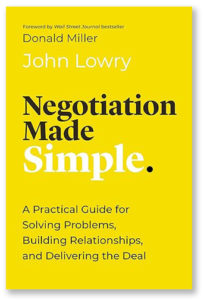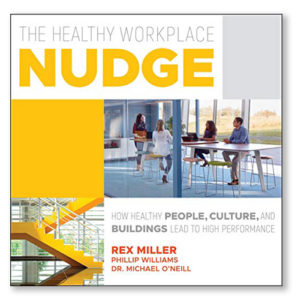We’re in a people world—people who agree with us, people who don’t. We’re also expected to provide a healthy work environment for facility occupants and visitors. Being a facility officer requires many talents that are not often taught by those who fill the role. Fortunately, the two books reviewed here may provide remedial education to help you succeed.
Negotiations Made Simple: A Practical Guide for Solving Problems, Building Relationships, and Delivering the Deal
Lowry, John, Harper Collins, NY, 2023, 240 pages, hardcover, $25; ebook, $12.
 When Getting to Yes was published in the 1990s, I joined several leaders in my institution attending a seminar, led by the Harvard Negotiation Project, to learn the techniques that were supposed to improve the relationships between the university administration and the unionized workforce, including the faculty. While the techniques had advantages, it seemed as if they relied on finding the gap between the positions of the negotiating parties.
When Getting to Yes was published in the 1990s, I joined several leaders in my institution attending a seminar, led by the Harvard Negotiation Project, to learn the techniques that were supposed to improve the relationships between the university administration and the unionized workforce, including the faculty. While the techniques had advantages, it seemed as if they relied on finding the gap between the positions of the negotiating parties.
There are still gaps between negotiating parties; if there weren’t, there would be no conflict—not likely. Now there is Negotiations Made Simple, by John Lowry, who identifies five techniques that can be applied to most, if not all, negotiations. The five techniques he presents, along with their intermediate actions, provide a nice listing of what to do and when.
As with any how-to-guide, each technique comes with a story or scenario to illustrate the points being made. Some of the techniques are multi-step or come with specific boundaries (mistakes to avoid in negotiations). As an example, when one is negotiating a contract, one generally follows the “mailbox approach,” in which a sender makes an offer that is delivered to the mailbox and reviewed by the receiver. If the offer is not acceptable, the roles are reversed (sender becomes receiver and receiver becomes sender), with counteroffers or more rounds of offers. This method leaves out one important step: the ability to determine a person’s interests and to find a cooperative solution. The mailbox approach is frequently used by win-lose parties in face-to-face discussions to find the interests of both parties. A different approach, “cooperation,” frequently results in a win-win solution. Lowry provides other examples of negotiating techniques with real stories that illustrate what success looks like, even when one side seems to have “lost.”
Developing a roadmap for negotiations is important, as is getting in a position of understanding and expressing empathy for the other’s interests. Obstacles can be overcome, and one can develop an approach to help the other side feel satisfied with the outcome. Negotiations Made Simple describes these important steps. Even if you don’t lead negotiating efforts with union or service providers, this book will help you understand what is happening and how to make supportive suggestions to reach a deal. Before your next negotiation, get Negotiations Made Simple.
The Healthy Workplace Nudge: How Healthy People, Culture, and Buildings Lead to High Performance
Miller, Rex, Phillip Williams, and Michael O’Neill, Wiley, NY, 2018, 320 pages, hardcover, $32; ebook, $19.
 What’s happening at our workplaces? Workers are getting less healthy, but forcing workers to improve their health habits is difficult and often backfires. There are likely many reasons, but the basic thesis for The Healthy Workplace Nudge is that individual health decisions are due to habits and inertia. As such, a nudge may be more effective than force.
What’s happening at our workplaces? Workers are getting less healthy, but forcing workers to improve their health habits is difficult and often backfires. There are likely many reasons, but the basic thesis for The Healthy Workplace Nudge is that individual health decisions are due to habits and inertia. As such, a nudge may be more effective than force.
The challenge is determining where the nudge should come from and how much should be applied to improve the health of the workplace (workers and visitors). The book identifies several sources for nudges to improve the health of individuals in the workplace.
No book about productivity and a healthy workplace would be complete without numbers and statistics, including how much money the average employee’s health benefits costs to an employer, as important as wages themselves, as well as where all those healthcare dollars go. These make for a compelling argument to improve the health of workers.
Providing a healthy environment promotes both physical and mental health. Facility officers can address many factors that contribute, including fresh air, appropriate lighting levels, comfortable furnishings, and an environment that promotes interactions with others in a mutually supportive way. Leadership is another factor. Supportive bosses who allow workers to be more productive through creativity and freedom in the workplace promote healthy environments as well.
Each chapter is filled with important points reinforced by stories that illustrate why the recommended action should be followed. The stories are compelling and provide both direct and indirect examples of where the workplace can be made healthier. Each chapter ends with a pair of nudges, one for the company leadership and one for the individual. These nudges are short and pithy, an opportunity for action and self-reflection to be healthier. The references are extensive, and many individuals are interviewed and participate on panels discussing opportunities to improve workplace health.
Reflecting on career choices and workplace environments, it’s clear that facility officers have a difficult job. Pressures from leadership and customers to provide low-cost services that make customers happy can make for an impossible task. Like utilities, healthcare is a mandatory expense. Finding where the expense can be reduced is the sweet spot. Facility officers can benefit by reading and applying The Healthy Workplace Nudge in the search for that sweet spot.
Ted Weidner is professor of engineering practice at Purdue University, West Lafayette, IN, and consults on facilities management issues, primarily for educational organizations. He can be reached at [email protected]. If you would like to write a book review, please contact Ted directly.
Bookshelf
Book reviews on current publications relevant to the profession, trends, and working environment of facilities and educational managers and professionals. To contribute a book review, contact Ted Weidner, field editor of this column.
See all Bookshelves.


